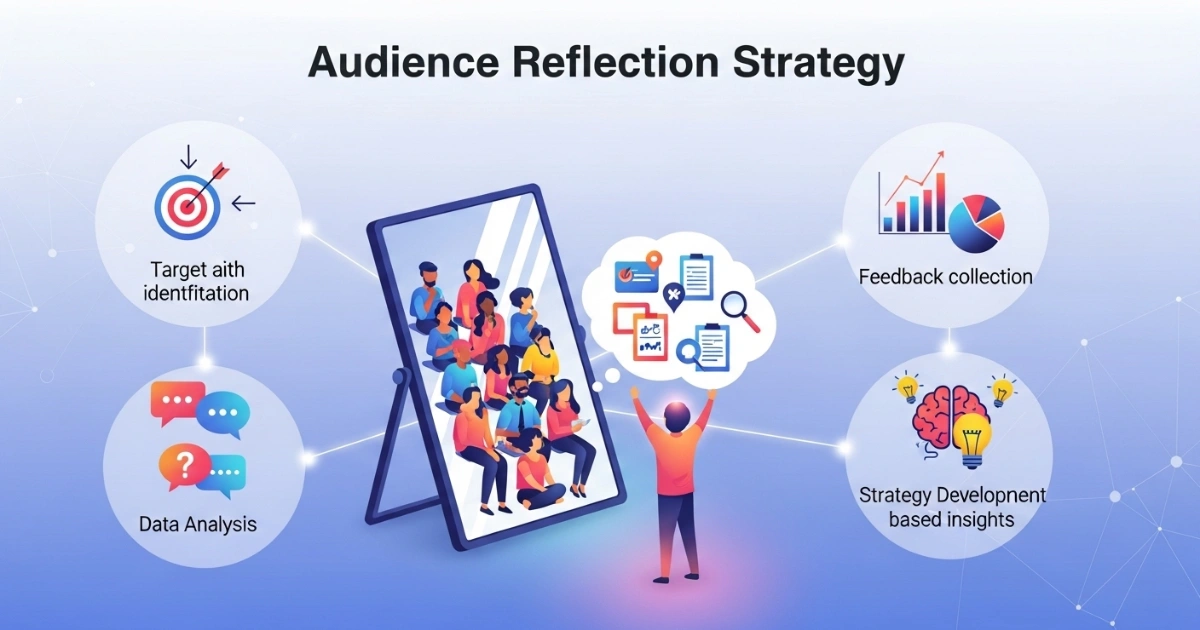Audience Reflection Strategy: Connect with Your Market

Contents
- 1 What is the Audience Reflection Strategy?
- 2 Why the Audience Reflection Strategy Matters
- 3 Key Components of the Audience Reflection Strategy
- 4 How to Implement the Audience Reflection Strategy
- 5 Tools to Support the Audience Reflection Strategy
- 6 Challenges and How to Overcome Them
- 7 Real-World Examples of the Audience Reflection Strategy
- 8 SEO Best Practices for the Audience Reflection Strategy
- 9 Measuring the Success of Your Strategy
- 10 Future Trends in Audience Reflection Strategy
In today’s fast-paced digital world, understanding your audience is the cornerstone of any successful marketing campaign. The audience reflection strategy is a powerful approach that allows businesses to dive deep into their audience’s needs, desires, and behaviors, fostering meaningful connections that drive engagement and loyalty. By reflecting on your audience’s preferences and tailoring your strategies accordingly, you can create content, products, and experiences that resonate profoundly. This article explores the audience reflection strategy in detail, offering actionable insights to help you connect with your target market more effectively. Whether you’re a marketer, business owner, or content creator, this guide will show you how to implement this strategy to maximize impact.
What is the Audience Reflection Strategy?
The audience reflection strategy is a methodical process of analyzing and understanding your target audience to create tailored marketing efforts. Unlike traditional market research, this approach emphasizes empathy, active listening, and iterative feedback to mirror your audience’s values, challenges, and aspirations. By doing so, businesses can craft messages and offerings that feel personal and relevant.
For instance, consider a fitness brand launching a new workout app. Instead of assuming what features users want, the brand uses the audience reflection strategy to survey potential customers, analyze their feedback, and observe their behavior on social platforms. This process reveals that users prioritize convenience and community support, leading the brand to focus on quick workouts and social features in the app.
Transitioning to a deeper understanding, let’s explore why this strategy matters in today’s competitive landscape.
Why the Audience Reflection Strategy Matters
In an era where consumers are bombarded with information, standing out requires more than just a catchy slogan or flashy ad. The audience reflection strategy matters because it:
- Builds Trust: By showing that you understand your audience’s needs, you foster trust and credibility.
- Increases Engagement: Tailored content resonates more, encouraging likes, shares, and comments.
- Boosts Conversions: Personalized experiences lead to higher conversion rates, as customers feel understood.
- Encourages Loyalty: When customers see their values reflected in your brand, they’re more likely to stay loyal.
For example, a 2023 study by HubSpot found that 80% of consumers are more likely to purchase from brands that personalize their experiences. This statistic underscores the importance of reflecting your audience’s preferences in your strategy.
Now, let’s dive into the key components of implementing this strategy effectively.
Key Components of the Audience Reflection Strategy
To implement the audience reflection strategy, you need a structured approach. Here are the core components:

1. Audience Research and Data Collection
The first step is gathering comprehensive data about your audience. This involves both quantitative and qualitative methods:
- Surveys and Questionnaires: Ask direct questions about preferences, pain points, and goals.
- Social Media Listening: Monitor conversations on platforms like X, Instagram, and LinkedIn to understand trending topics and sentiments.
- Analytics Tools: Use tools like Google Analytics or Hotjar to track user behavior on your website.
- Customer Feedback: Collect reviews, testimonials, and feedback from customer support interactions.
For example, a small e-commerce business might use Google Forms to survey customers about their shopping habits, revealing that 60% prefer eco-friendly packaging. This insight shapes their packaging strategy, aligning with audience values.
2. Creating Detailed Audience Personas
Once you have data, create detailed audience personas. These are fictional representations of your ideal customers, including demographics, interests, behaviors, and challenges. A well-crafted persona might include:
- Demographics: Age, gender, location, income level.
- Psychographics: Values, interests, lifestyle choices.
- Pain Points: Challenges or problems they face.
- Goals: What they hope to achieve.
For instance, a persona for a tech startup might be “Sarah, a 30-year-old freelance graphic designer who values flexibility and seeks affordable, user-friendly software.” This persona guides content creation and product development.
3. Empathy Mapping
Empathy mapping takes personas a step further by exploring what your audience thinks, feels, says, and does. This tool helps you step into your audience’s shoes, ensuring your strategy aligns with their emotional and practical needs.
To create an empathy map, divide a page into four quadrants:
- Thinks: What are their thoughts or concerns?
- Feels: What emotions drive their decisions?
- Says: What do they express verbally or online?
- Does: What actions do they take?
For example, a travel agency might discover that their audience feels anxious about booking international trips due to safety concerns. This insight prompts the agency to create reassuring content, like safety guides or traveler testimonials.
4. Content Personalization
With insights from research and empathy mapping, tailor your content to reflect your audience’s preferences. This includes:
- Blog Posts: Write about topics that address their pain points or interests.
- Social Media: Share content that aligns with their values, such as sustainability or innovation.
- Emails: Use personalized subject lines and content based on user behavior.
- Product Offerings: Develop products or features that solve specific problems.
For instance, a skincare brand might create blog posts about “How to Care for Sensitive Skin” after learning that 40% of their audience struggles with skin sensitivity.
5. Iterative Feedback and Refinement
The audience reflection strategy is not a one-time effort. Continuously collect feedback and refine your approach. Use A/B testing, customer surveys, and analytics to measure what works and what doesn’t. For example, if a clothing brand notices low engagement on a new ad campaign, they might survey customers to learn why and adjust the campaign accordingly.
Transitioning to practical steps, let’s explore how to implement this strategy in your business.
How to Implement the Audience Reflection Strategy
Implementing the audience reflection strategy requires a clear plan. Here’s a step-by-step guide:

Step 1: Define Your Goals
Start by identifying what you want to achieve. Are you aiming to increase website traffic, boost sales, or improve customer retention? Clear goals guide your research and content efforts. For example, a goal might be “Increase email open rates by 20% in six months.”
Step 2: Conduct In-Depth Research
Use the research methods mentioned earlier—surveys, social listening, and analytics—to gather data. Focus on understanding your audience’s motivations and challenges. For instance, a SaaS company might analyze X posts to identify common complaints about project management tools, informing their product updates.
Step 3: Develop Personas and Empathy Maps
Create 2-3 detailed personas based on your research. Then, use empathy mapping to understand their emotional drivers. This step ensures your strategy is rooted in real insights, not assumptions.
Step 4: Create and Distribute Tailored Content
Develop content that speaks directly to your personas. For example, a pet food brand might create a blog series on “Healthy Diets for Senior Dogs” after learning that 30% of their audience owns older pets. Share this content across relevant channels, like email, social media, and your website.
Step 5: Measure and Optimize
Track key metrics like engagement, click-through rates, and conversions. Use tools like Google Analytics or HubSpot to monitor performance. If a campaign underperforms, gather feedback to understand why and make adjustments. For example, if a video ad has low views, you might test a shorter version to see if it performs better.
Step 6: Iterate and Scale
As you collect more data, refine your personas and content. Scale successful strategies by investing more resources in what works. For instance, if personalized emails drive high conversions, consider automating personalization with tools like Mailchimp.
Tools to Support the Audience Reflection Strategy
Several tools can streamline the audience reflection strategy:

- Google Analytics: Tracks website behavior and demographics.
- Hotjar: Provides heatmaps and user session recordings.
- SurveyMonkey: Creates and distributes surveys.
- Hootsuite: Monitors social media conversations.
- Mailchimp: Personalizes email campaigns.
- Tableau: Visualizes audience data for deeper insights.
For example, a bakery might use Hotjar to see which website pages attract the most clicks, revealing that customers love their gluten-free recipes. This insight prompts a new blog series on gluten-free baking.
Challenges and How to Overcome Them
While powerful, the audience reflection strategy comes with challenges:
- Data Overload: Collecting too much data can be overwhelming. Focus on key metrics that align with your goals.
- Misinterpreting Feedback: Avoid assumptions by cross-referencing data from multiple sources, like surveys and analytics.
- Resource Constraints: Small businesses may lack time or budget. Start with free tools like Google Forms and social listening on X.
- Keeping Up with Trends: Audiences evolve, so regularly update your personas and strategies.
For instance, a startup might struggle to analyze large datasets. By focusing on one platform, like Instagram, they can gather actionable insights without needing advanced tools.
Real-World Examples of the Audience Reflection Strategy

Example 1: Nike’s Inclusive Marketing
Nike excels at the audience reflection strategy by listening to its diverse audience. Through social media listening and surveys, Nike learned that inclusivity matters to its customers. This led to campaigns featuring athletes of all abilities, boosting brand loyalty among underrepresented groups.
Example 2: Glossier’s Community-Driven Products
Beauty brand Glossier uses the audience reflection strategy to co-create products with its community. By engaging customers on Instagram and gathering feedback, Glossier developed products like their Milky Jelly Cleanser, which became a bestseller due to its alignment with customer needs.
Example 3: Local Coffee Shop’s Social Media Success
A small coffee shop used the audience reflection strategy to boost engagement. By analyzing X posts, they discovered that their audience loved latte art. They started posting daily latte art videos, increasing their followers by 25% in three months.
SEO Best Practices for the Audience Reflection Strategy
To maximize the reach of your audience reflection strategy, incorporate SEO best practices:

- Keyword Optimization: Use the main keyword, “audience reflection strategy,” naturally in headings, subheadings, and body text. Maintain a 1% keyword density (approximately 30-35 uses in a 3000-3500 word article).
- Internal Linking: Link to related blog posts on your website to keep readers engaged.
- External Linking: Reference credible sources, like HubSpot or Google Analytics, to boost authority.
- Alt Text for Images: Use descriptive alt text, like “Audience reflection strategy empathy map,” for accessibility and SEO.
- Mobile Optimization: Ensure your blog is mobile-friendly, as 60% of searches occur on mobile devices (Statista, 2024).
- Engaging Headlines: Use compelling subheadings to improve readability and keep readers on the page.
For example, include a call-to-action (CTA) like “Download our free audience reflection strategy guide” to encourage engagement and capture leads.
Measuring the Success of Your Strategy
To gauge the effectiveness of your audience reflection strategy, track these metrics:
- Engagement Metrics: Likes, shares, comments, and time spent on page.
- Conversion Rates: Percentage of visitors who take desired actions, like signing up or purchasing.
- Customer Retention: Repeat purchases or subscription renewals.
- Net Promoter Score (NPS): Measures customer loyalty through surveys.
For instance, if your NPS increases by 10 points after implementing personalized emails, it’s a sign your strategy is working.
Future Trends in Audience Reflection Strategy
As technology evolves, so does the audience reflection strategy. Emerging trends include:

- AI-Powered Insights: Tools like Grok 3 can analyze vast amounts of audience data, providing deeper insights in real-time.
- Voice Search Optimization: With 50% of searches expected to be voice-based by 2026 (Gartner), tailor content for conversational queries.
- Hyper-Personalization: Use machine learning to deliver hyper-targeted content, like personalized product recommendations.
- Community Building: Focus on creating online communities where audiences can share feedback directly.
For example, a retailer might use AI to analyze X posts and predict trending products, ensuring their strategy stays ahead of the curve.
Conclusion
The audience reflection strategy is a game-changer for businesses aiming to connect deeply with their target market. By researching your audience, creating personas, mapping their emotions, and personalizing content, you can build trust, boost engagement, and drive conversions. While challenges like data overload or resource constraints may arise, using the right tools and staying focused on your goals can overcome them. Start implementing this strategy today by conducting a simple survey or analyzing social media conversations. With consistent effort and iteration, your brand can create experiences that resonate and foster lasting loyalty.






